The digital content world has been turned upside down by artificial intelligence. AI ghostwriting tools help writers, marketers, and business owners create high-quality content faster. Let’s explore how these technologies work, their real-world uses, and how to blend them into your content workflow.
What is AI Ghostwriting?
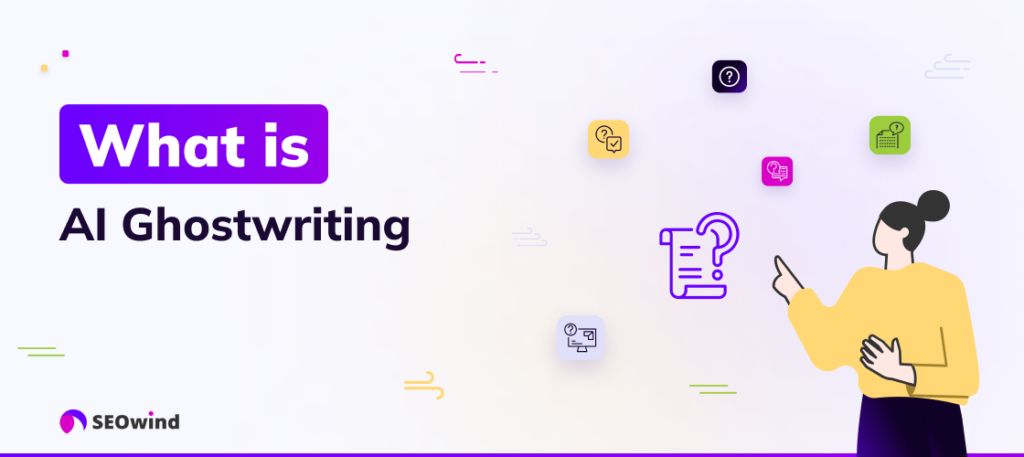
AI ghostwriting uses advanced language models to generate content that feels like it was written by a human. Like traditional ghostwriting, the AI creates content someone else will put their name on. Still, it uses intelligent algorithms instead of human creativity as its base.
What is the difference between a ghostwriter and an AI ghostwriter?
Traditional ghostwriters are people hired to write content that gets credited to someone else. They bring real-world experience, emotional intelligence, and creative flair to their work. On the other hand, AI ghostwriters use Natural Language Processing (NLP), machine learning, and complex algorithms to generate content based on what you tell them to do.
Research from Plagiarism Search shows that businesses using AI in their ghostwriting process save tons of time while keeping quality high when humans properly oversee the work. Companies can create article drafts in seconds, freeing writers to focus on more valuable tasks like developing creative ideas and checking facts.
Can I use AI for ghostwriting?
Yes, you can use AI tools for ghostwriting, but you need to understand the “CyborgMethod™” approach to do it well. This hybrid method treats AI as your assistant rather than your replacement, combining AI’s efficiency with human expertise, strategic thinking, and quality control.
Tom Winter, CGO at SEOwind, says, “I use AI as my first-draft machine, research assistant, and brainstorming partner. This lets me focus my human energy on refining, fact-checking, and adding the authentic voice that only comes from personal experience.”
Comparative Analysis: Traditional Ghostwriting vs. AI Ghostwriting
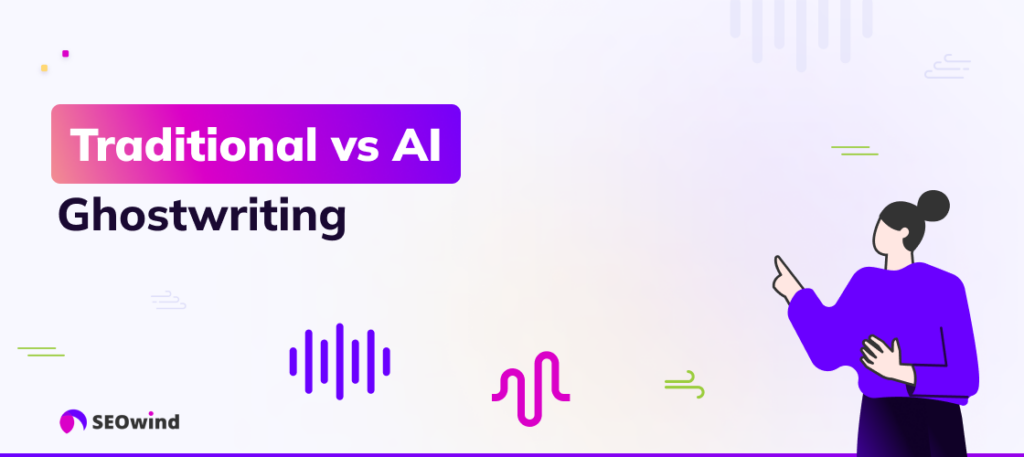
When choosing between traditional ghostwriters and AI tools, here are the key differences to consider:
Costs and Time Efficiency
Traditional ghostwriters typically charge between $0.10-$2.00 per word based on their expertise and how complex the content is. Projects often take days or weeks, with multiple rounds of revisions.
AI ghostwriting tools can save you a lot of money, with subscriptions ranging from $20-$200 monthly for unlimited content generation. A Salesforce report shows that 76% of marketers already use AI for basic content creation, mainly because it saves them time.
Quality and Authenticity of Content
Human ghostwriters excel at capturing subtle emotions, cultural references, and industry insights. They can interview people, interpret complex data, and create original perspectives.
AI ghostwriting has improved, but it still struggles with certain quality aspects. According to Zebracat research, AI-assisted blog writing tools increase organic traffic by 120% within 6 months. Still, this success depends on professional human editing. Content with proper human oversight performs way better than purely AI-generated content, showing how vital the hybrid approach is.
Creative Control and Customization
Traditional ghostwriters build collaborative relationships, doing interviews and research to accurately capture the client’s voice and message.
AI ghostwriting tools offer more and more customization through detailed prompts, style settings, and tone adjustments. However, they need clear direction, as Tom Winter, CGO at SEOwind, points out: “AI should be onboarded like a new team member. It needs clear task definitions, goals, and context. Success depends almost entirely on the quality of your input.”
The Mechanisms Behind Ghostwriting AI Software
To get the most from AI ghostwriting tools, you must understand what powers them and how they’ve evolved.
How AI Writes: NLP, Machine Learning, and Algorithms Explained
Modern AI ghostwriting runs on increasingly sophisticated large language models (LLMs) like GPT-4, Claude, and others that have revolutionized content creation:
Natural Language Processing Evolution: Today’s AI models use advanced techniques with billions of parameters that help them understand context, write coherent paragraphs, and keep stories consistent across long articles.
Training Data Sophistication: Leading models learn from diverse sources, including books, articles, and websites, helping them understand different writing styles, industry terms, and content structures. This extensive training lets them create appropriate content for specific industries or audiences.
Contextual Understanding: Unlike earlier AI that produced generic, often nonsensical text, current models show remarkable contextual awareness, allowing them to maintain consistent arguments, develop themes logically, and generate content that reads naturally.
Personalization Techniques: Adapting Voice and Style
Effective AI ghostwriting needs sophisticated personalization to match brand voice and content requirements:
Example-Based Learning: Modern AI tools can analyze samples of previous content to identify and copy writing patterns, vocabulary choices, and stylistic elements unique to a brand or person.
Parameter Adjustments: Advanced systems let you adjust sentence complexity, vocabulary sophistication, formality level, and other stylistic elements to match specific requirements.
Voice Modeling Technology: The latest tools can maintain consistent “character voices” throughout long-form content, preserving the unique linguistic traits that define a brand’s communication style.
Without strong voice inputs, AI defaults to bland, generic output. That’s why examples of past content are essential—they help the AI understand your unique tone and replicate it. Whether your voice is casual, authoritative, witty, or punchy, you must show the AI what ‘good’ looks like.
Key Advantages of Using Ghostwriting AI for Various Sectors
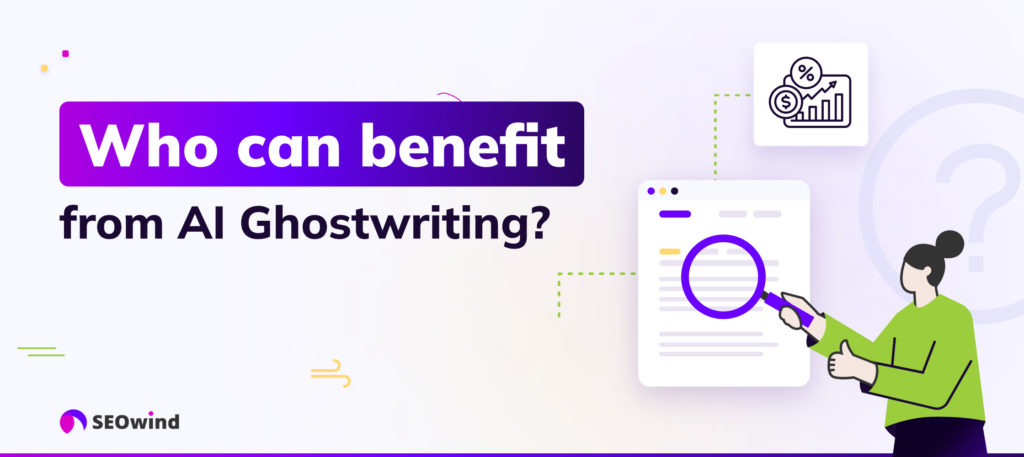
AI ghostwriting technology offers significant benefits across multiple industries, each sector finding unique advantages.
Accelerating Content Production for Digital Marketing
For digital marketers, time is money. The faster they can produce high-quality content that resonates with For marketing teams facing growing content demands, AI ghostwriting tools have become invaluable production assistants:
Content Scalability: Marketing teams can tackle multiple channels at once, with AI helping create variations of core content tailored to different platforms and audiences.
Consistent Publication Schedules: According to a Statista survey, approximately 82% of public relations professionals worldwide use generative AI to ideate or brainstorm, while 72% use it to write first drafts, helping teams maintain publishing consistency.
SEO-Optimized Output: Many AI systems now include search optimization features, analyzing keyword opportunities and helping marketers create content that balances reader engagement with search visibility.
AI in Academic Research and Writing Assistance
In academic settings, AI serves as a valuable research assistant rather than replacing scholarly writing:
Literature Review Acceleration: Researchers use AI to summarize and analyze vast amounts of published literature, finding relevant studies and key findings much faster than manual methods allow.
Structural Support: Academic writers use AI to create initial drafts of standard sections like methodology descriptions or results presentations, allowing them to focus more on analysis and interpretation.
Language Polishing: Non-native English speakers in academia benefit from AI tools that help refine language usage while maintaining technical accuracy.
Benefits for Authors and Publishers
The publishing industry has found numerous applications for AI assistance in the content development process:
Developmental Editing: Authors use AI to identify structural weaknesses in manuscripts, flagging inconsistencies in character development, plot holes, or logical gaps.
Market Analysis: Publishers leverage AI to analyze successful titles within genres, identifying trending themes and potential market opportunities.
Content Expansion: Fiction and nonfiction writers use AI to develop secondary content like blog posts, newsletters, and social media materials that support their primary publications.
Common Failures When Implementing AI Ghostwriting
Despite the promising benefits, AI ghostwriting implementation often runs into significant pitfalls. Understanding these common failures can help organizations avoid costly mistakes.
Citation and Reference Issues
One of the most notorious AI failures is its tendency to make up fake citations. According to Unemployed Professors, AI systems don’t read or understand research materials. Instead, pull random references and force them into text without comprehending their relevance.
For example, an AI might cite “Smith, J. (2004). The Role of Economic Factors in 20th-Century Conflicts. Cambridge University Press.” in an essay about World War I. Still, the book might not even mention World War I. These made-up references undermine content credibility, especially in academic or professional contexts.
Misaligned Use Cases and Lack of Strategy
Recent data from NTT Data indicates that 70-85% of general AI initiatives fail to meet their expected outcomes, with ghostwriting applications being no exception. This failure rate far exceeds the regular IT projects’ 25-50% failure rate.
Many organizations implement AI ghostwriting tools without a clear strategy, rushing to adopt the technology without defining specific use cases or ensuring it meets real user needs. This results in AI writing tools that don’t address content requirements or business objectives.
Customer Service Content Failures
The Air Canada chatbot incident shows how AI writing systems can provide inaccurate information with serious consequences. The chatbot incorrectly told a passenger seeking a bereavement fare to book a regular fare and request a partial refund within 90 days.
When the passenger followed this advice, Air Canada denied the refund request, claiming they couldn’t be held liable for information provided by their chatbot. The case eventually went to the Civil Resolution Tribunal of British Columbia, which ruled in the passenger’s favor and ordered Air Canada to honor the chatbot’s offer.
A Step-by-Step Guide to Integrating Ghostwriting AI into Your Workflow

Successfully implementing AI ghostwriting requires a thoughtful approach that combines technological capabilities with human oversight. Here’s a practical framework for integration:
Step 1: Evaluate the Right Ghostwriting AI Tools for Your Needs
It’s crucial to start out by finding the ghostwriter AI tool that fits your needs to a T. Here are some conSelecting the appropriate AI writing assistant depends on your specific requirements:
- Content Type Compatibility: Different AI tools excel at different content formats. Some perform better with short-form content like social posts and product descriptions. In contrast, others specialize in long-form articles or creative writing.
- Technical Sophistication: Consider whether you need advanced features like SEO optimization, readability analysis, or style customization versus simpler drafting capabilities.
- Integration Requirements: Evaluate how the tool will fit into your existing content workflow, including compatibility with content management systems or team collaboration platforms.
- Pricing Structure: Assess whether per-word, subscription, or credit-based pricing models best align with your content volume and budget constraints.
Step 2: Collaborate with AI – From Drafting to Finishing Content
The most effective AI ghostwriting implementation follows a collaborative human-AI workflow:
1. Strategic Direction: Before engaging AI, begin with clear content objectives, audience definition, and key messages.
2. Detailed Briefing: Provide the AI with comprehensive context, including:
- Target audience characteristics
- Desired outcomes and calls to action
- Brand voice guidelines and examples
- Subject matter expertise and key points
- Competitor insights and differentiation angles
3. Initial Generation: Use AI to produce a structured first draft based on your brief.
4. Human Refinement: Apply critical review, factual verification, and stylistic improvements to transform the AI draft into publication-ready content.
5. Feedback Loop: Document successful prompts and approaches to continuously improve your AI collaboration process.
This is a collaborative creation process. AI provides a fast, structured starting point; the human transforms it into a final product that’s insightful, original, and aligned with business goals. Like a ghostwriter and their client, the relationship is built on trust, clarity, and refinement.
Step 3: Quality Assurance: Editing, Plagiarism Checks, and Fact-Verification
Maintaining content integrity requires rigorous quality control when working with AI:
- Comprehensive Editing: Human editors should review AI-generated content for logical flow, factual accuracy, and brand voice consistency.
- Plagiarism Detection: Use specialized tools to verify the originality of AI outputs, as some models may occasionally reproduce training data too closely.
- Fact Verification: Implement a systematic process to verify claims, statistics, and references in AI-generated content against reliable sources.
- Style Consistency: Ensure the final content aligns with your brand’s established style guides and communication standards.
Even great AI-generated content sometimes feels off: too stiff, too robotic. That’s where post-processing comes in, tweaking word choices, adjusting cadence, and stripping out clichés to ensure the content feels natural, engaging, and authentic.
Getting Started Checklist: Implementing AI Ghostwriting in Your Organization
Use this actionable checklist to begin integrating AI ghostwriting into your content workflow:
- Assess Content Needs: Identify specific content types and volumes that would benefit most from AI assistance
- Catalog recurring content formats (blogs, social posts, product descriptions, etc.)
- Calculate current production time and resource allocation
- Determine priority content areas based on volume and standardization potential
- Tool Selection and Setup:
- Evaluate 3-5 AI tools based on your specific content requirements
- Set up trial accounts and test with real content briefs from your organization
- Document performance across different content types
- Select primary and specialized tools for different use cases
- Process Development:
- Define clear roles for AI vs. human contributors in each content type
- Create standard operating procedures documenting the entire workflow
- Develop template prompts for recurring content needs
- Establish quality control checkpoints
- Team Training:
- Provide hands-on training for content team members
- Create prompt libraries and best practices documentation
- Set realistic expectations about AI capabilities and limitations
- Develop evaluation criteria for AI-assisted content
- Implementation Monitoring:
- Track time savings, content quality metrics, and team satisfaction
- Document challenges and develop solutions collaboratively
- Regularly review and refine prompts based on results
- Establish weekly team reviews of AI-assisted content
Comparison of Top AI Ghostwriting Tools for 2025
When selecting an AI ghostwriting tool, understanding the strengths and limitations of leading options helps match capabilities to your specific needs.
| Tool | Key Features | Pricing | Best For | Limitations |
|---|---|---|---|---|
| ChatGPT (OpenAI) | Versatile content generation, multimodal capabilities, custom GPTs, wide topic knowledge | $20/month (Plus); $200/month (Pro) | General ghostwriting, creative ideation, versatile content types | Can be verbose; requires fact-checking; occasionally hallucinates information |
| Claude (Anthropic) | Nuanced prose, strong tone-matching, excellent for long-form content | $20/month (Pro) | Long-form articles, sophisticated prose, client-specific content | Sometimes overly cautious; less effective for technical content |
| Jasper | Marketing-focused templates, SEO integration, collaborative workspace | From $39/month | Marketing copy, promotional content, advertising materials | Less nuanced for narrative writing; higher price point |
| Perplexity | Research-focused, citation capabilities, factual accuracy | Free tier; Pro $20/month | Research-based content, factual writing, citation-heavy articles | Less creative flexibility; primarily informational |
| SEOwind | – AI articles EEAT focused – Content updates improving EEAT – SEO optimization, – Content briefs, – SEO research – Built-in AI agents that do research, review and refine | From $49/month | SEO-focused content, blog articles, authority building | Specialized for articles and blog posts |
The most successful implementations don’t rely on a single AI tool but instead use multiple specialized tools for content creation, research, drafting, editing, and optimization, followed by substantial human refinement.
SEOwind – a Powerful Tool for Ghostwriting with AI
If you’re serious about ghostwriting with AI and you care about quality, search performance, and consistency, then SEOwind is one of the few tools built specifically for that level of precision. Unlike general-purpose AI writers that spit out average content, SEOwind was designed from the ground up to support expert-level content creation that ranks and converts.
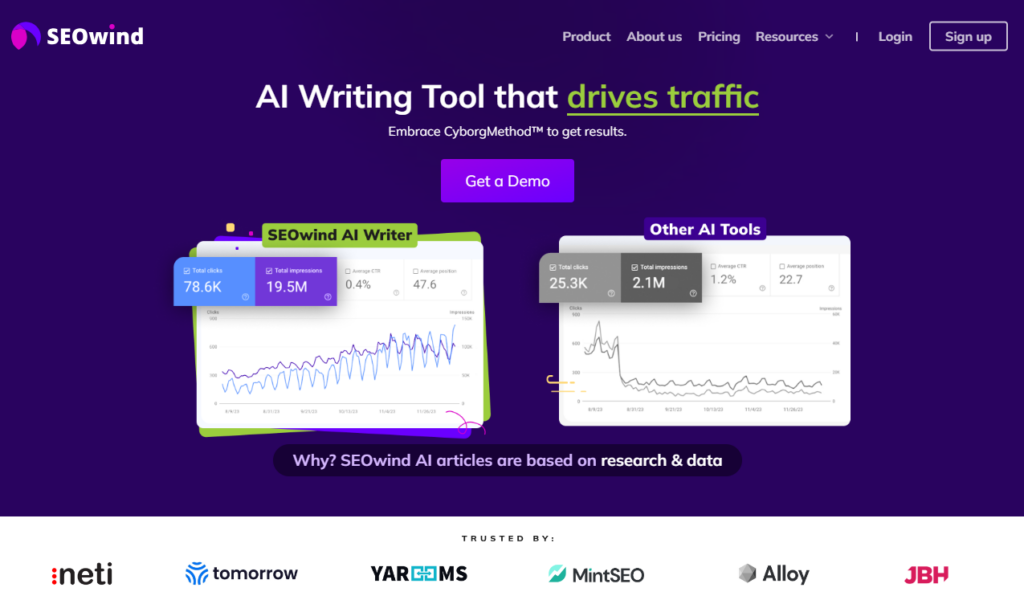
What makes it different? It doesn’t just generate text. SEOwind starts with deep research: pulling top-ranking content, analyzing search intent, clustering keywords, and structuring comprehensive content briefs. You’re not feeding AI vague prompts; you’re giving it battle-tested, SEO-optimized input backed by real data.
Why Ghostwriters Use SEOwind:
- Structured Briefs, Instantly: Instead of starting with a blank page, you get detailed outlines with headings, questions, and keyword clusters tailored to the topic.
- EEAT-Optimized Outputs: SEOwind uses internal and external data to create drafts that align with Google’s EEAT guidelines, which are perfect for ghostwriters who need to project authority.
- Voice Training & Human Refinement: You can personalize tone, input your own examples, and combine the draft with your experience using what we call the CyborgMethod™—a hybrid approach where AI handles the heavy lifting, and you inject the magic.
Tom Winter, CGO at SEOwind, puts it plainly:
“AI without research is guessing. SEOwind gives the AI context, structure, and a clear purpose so you get content that’s not only readable but actually useful.”

If your ghostwriting needs go beyond fluff and into expert-level storytelling, SEOwind will be your tool.
Tips and Best Practices for Leveraging Ghostwriting AI Successfully
Based on experiences from professional content creators, these strategies will help maximize the effectiveness of your AI ghostwriting implementation:
- Input Quality Determines Output Quality: Provide detailed, specific prompts that include audience information, desired tone, key points, and examples of preferred writing styles. AI isn’t a search engine. It’s a logical engine. The more context you give it, the less likely it is to hallucinate.
- Develop a Custom Prompt Library: Create and refine a collection of effective prompts for different content types and objectives, allowing consistent results across team members and projects.
- Implement a Multi-Stage Process: Use AI for different stages of content creation: research gathering, outlining, first draft generation, and editing suggestions rather than expecting perfect content in a single step.
- Maintain Brand Consistency: Provide the AI with style guides, voice documentation, and examples of successful content to ensure outputs align with established brand standards.
- Focus Human Effort on Strategic Elements: Dedicate human expertise to areas where AI struggles most: strategic thinking, emotional resonance, cultural nuance, and specialized subject matter expertise.
- Establish Clear Editorial Guidelines: Create specific criteria for reviewing AI-generated content, including factual accuracy, brand alignment, logical structure, and audience relevance.
The process itself is iterative. One prompt won’t cut it. You refine, test, and iterate. Prompting is a creative process, not a one-and-done command. Expect multiple cycles from research to briefing to drafting to refining before you hit the final publishable version. consistently while saving substantial time and effort otherwise spent on conventional writing processes.
Ethical and Legal Considerations for AI Ghostwriting
As AI writing technology advances, understanding the ethical and legal landscape becomes increasingly important for content creators.
Copyright and Ownership Guidelines
The legal status of AI-generated content continues to evolve, with important implications for content creators:
- US Copyright Office Position: As of 2023, works involving human creativity assisted by AI can be copyrighted as long as humans played a meaningful creative role. However, purely AI-generated content without substantial human input is not eligible for copyright protection.
- Ownership Documentation: When using AI ghostwriting professionally, establish clear contractual agreements regarding content ownership, particularly when creating content for clients or employers.
- Attribution Requirements: Consider whether and how to disclose the use of AI in content creation, particularly for academic, journalistic, or creative works where transparency expectations may be higher.
Best Practices for Ethical AI Content Creation
Maintaining ethical standards while leveraging AI technology requires intentional practices:
- Transparency with Stakeholders: Establish clear policies about when and how AI is used in your content creation process, and communicate these appropriately to relevant audiences.
- Quality Control Systems: Implement rigorous fact-checking procedures for AI outputs, as language models can confidently present incorrect information.
- Human-in-the-Loop Approach: Ensure meaningful human oversight of AI-generated content, particularly for sensitive topics, specialized information, or content with potential real-world impacts.
- Originality Verification: Use plagiarism detection tools to identify human-written and AI-generated duplicate content.
The Alliance of Independent Authors advises that ethical best practices include avoiding deception about AI involvement and ensuring that any human claiming authorship has exercised creative judgment, editing, and review over the AI-generated content.
The Future of Ghostwriting AI
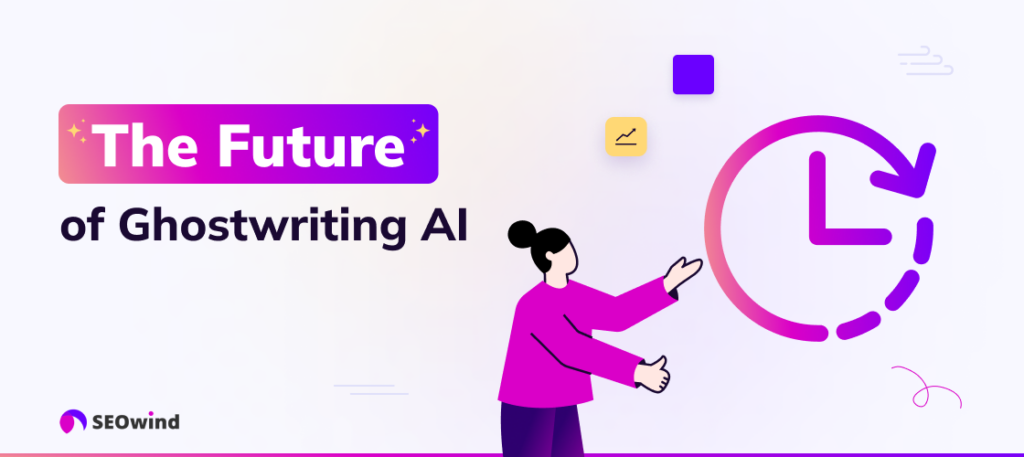
AI ghostwriting technologies will continue to evolve, presenting opportunities and challenges for content creators.
Predictions on Advancements in AI Writing Technology
The coming years will likely bring significant changes to AI writing capabilities:
- Increased Personalization: Future AI tools will offer more sophisticated personalization, adapting not just to brand voice but to specific audience segments and individual reader preferences.
- Multimodal Content Creation: AI systems will increasingly integrate text, image, audio, and video generation capabilities, enabling more comprehensive content production.
- Enhanced Domain Expertise: Specialized AI models trained on industry-specific content will deliver more accurate, nuanced outputs for technical, legal, medical, and other specialized fields.
- Real-Time Adaptation: AI writing systems will evolve to incorporate real-time performance data, adjusting content strategies based on engagement metrics and conversion patterns.
Impact on Professional Writers and the Writing Industry
The integration of AI ghostwriting technology will continue to reshape professional writing careers:
- Skill Evolution: Professional writers will increasingly need to develop AI collaboration skills, prompt engineering expertise, and strategic content planning capabilities.
- New Career Specializations: Emerging roles will include AI content strategists, prompt engineers, and AI-human collaboration specialists who excel at getting optimal results from writing technologies.
- Quality Differentiation: Human expertise will become increasingly valued for adding distinctive perspectives, emotional resonance, and creative approaches that AI cannot replicate.
- Productivity Transformation: Writers who effectively leverage AI tools will dramatically increase their output capacity, potentially changing compensation models from per-word to value-based structures.
To transform AI content from decent to standout, human insight and personal experience are essential. Real stories, subject matter expertise, industry-specific perspectives, these elements can’t be faked or generated. They make content memorable and meaningful.
FAQ on Ghostwriting AI
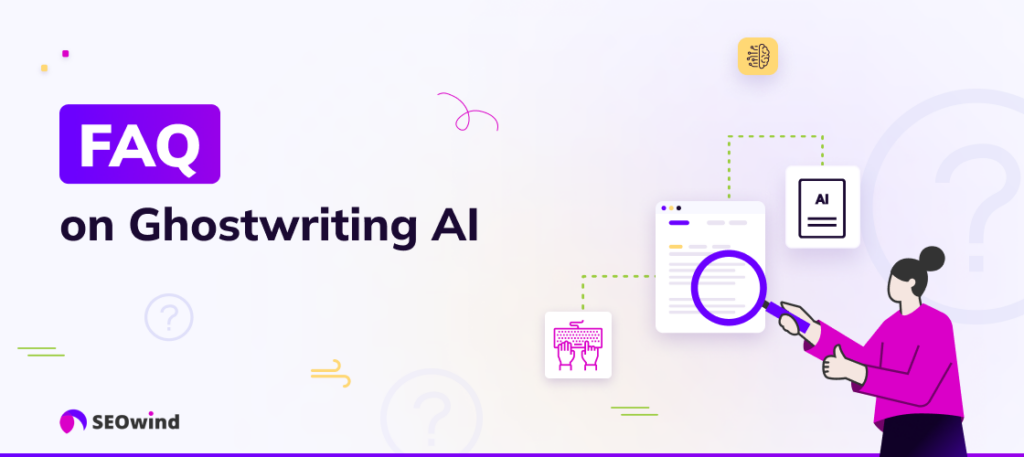
Is Ghostwriting Illegal?
No, ghostwriting is not illegal. It’s a well-established practice in publishing, speech writing, content marketing, and many other fields. The legitimacy of ghostwriting hinges on the agreement between the client (the named author) and the writer who creates the content but remains uncredited.
However, ethical considerations arise when ghostwriting involves plagiarism or misrepresentation, particularly in academic contexts where original work is expected. The legality centers on the contractual agreement rather than the practice itself.
If AI wrote a book for me, is it OK to put my name on it?
From a legal perspective, you can put your name on AI-generated content that you’ve commissioned and edited, as you control the final product. However, several important considerations apply:
- Copyright Limitations: According to the US Copyright Office’s February 2023 ruling, purely AI-generated content without significant human creative input is not eligible for copyright protection.
- Ethical Transparency: Professional writing associations increasingly recommend disclosing AI assistance, particularly for creative or authored works, to maintain trust with readers.
- Quality Control Responsibility: By putting your name on AI-generated content, you accept responsibility for its accuracy, originality, and quality, making a thorough review essential.
The most respected approach combines AI assistance with substantial human direction, editing, and enhancement, allowing you to legitimately claim authorship of the final work.
Is AI a threat to ghostwriters?
AI presents both challenges and opportunities for professional ghostwriters. According to a Statista survey, approximately 82% of PR professionals use generative AI to ideate or brainstorm, indicating adaptation rather than replacement.
The key differentiators that human ghostwriters maintain include:
- Emotional Intelligence: Understanding subtle emotional nuances and cultural contexts that AI models still struggle to fully grasp.
- Original Research: Conduct interviews, synthesize unpublished information, and gather primary source material that isn’t available in AI training data.
- Strategic Thinking: Aligning content with complex business goals and audience needs in ways that require human judgment and experience.
- Creative Innovation: Developing original concepts, angles, and approaches rather than variations on existing content patterns.
Most successful ghostwriters are adopting a hybrid approach, using AI to handle routine aspects of writing while focusing their human expertise on the elements that add unique value and quality.
What AI tool would you recommend for ghostwriting a book?
For book-length ghostwriting projects, the tool recommendation depends on your specific needs:
- For Fiction and Creative Nonfiction: Claude (by Anthropic) excels at maintaining consistent character voices and narrative flow across long-form content, making it suitable for creative writing projects.
- For Research-Based Nonfiction: A combination of Perplexity for research gathering and fact-checking alongside ChatGPT for draft generation provides a balanced approach to informational content.
- For Technical or Business Books: Specialized tools like SEOwind can help ensure content aligns with industry terminology and search patterns while maintaining readability.
Professional writers emphasize that book projects require substantial human oversight, refinement, and strategic direction regardless of the tool selected. The most effective approach treats AI as a collaborative partner rather than an autonomous creator, with humans providing creative direction and quality control throughout the process.


